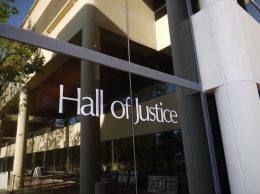For most of the summer, Ventura County was at the heart of a statewide debate over public-sector pensions.
Reformers spent tens of thousands of dollars on a proposed referendum to change Ventura County’s public employee retirement system from a defined-benefit system to a 401(k)-style system. On Aug. 4, the battle ended when a judge struck the measure from the November ballot.
But the war over public-sector pensions is far from over. Above the tangle of details hovers a fundamental debate about the fiscal stability of local governments, the vanishing middle class, inequality and the future of organized labor.
Ventura County’s pension system is the region’s largest and has drawn the most scrutiny from opponents. But it is also the strongest and has undergone big changes that haven’t yet come to Santa Barbara or San Luis Obispo counties. And the issues raised in the fight in Ventura County are likely to increase in prominence throughout the Tri-Counties as public-sector baby boomers begin to retire en masse.
Two different worlds
There are huge differences between how public pension systems and private pension systems are set up.
The public sector generally uses defined-benefit pension systems to pay for employees’ retirements. Like salary, health care and other perks, retirement benefits are an important part of an employee’s compensation package. In California, these systems guarantee individual employees a specific amount every year after they retire based on a formula that includes final years’ salaries, age and years of service.
The private sector has seen a marked shift away from pension systems and into defined-contribution systems, which are less risky for employers. Defined-contribution systems function like a savings account where employers and employees can contribute a specific percentage of a salary every year. When it comes time to retire, the employee gets access to the full amount in the account but has no yearly guarantee. According to consulting firm Towers Watson, only 30 firms among the Fortune 100 offered pension-style plans to new hires in 2013, down from 73 in 2004.
Because defined-benefit pensions last until an employee dies, many private-sector workers and retirees will continue to receive pensions for years to come. But as new employees join the workforce, 401(k)-style plans are becoming the norm.
Target for reformers
The proposed ballot measure would have switched all future Ventura County employees from a pension-style system to a 401(k)-style system. Current employees and retirees would have kept their pensions.
The debate over public pensions comes down to fundamental questions of money and risk. Should the county — and thus taxpayers — be on the hook when investments don’t turn out well or when public employees retire at 50? Should employees who devote their lives to public service be left impoverished if they outlive their savings?
Ending its defined-benefit system “will have a devastating impact on the quality of life and services in Ventura County,” said Steven Maviglio, a spokesperson for one of the groups that successfully defeated the reform. Pensions are “what attracts [employees] and keeps them in public service.” But David Grau, chairman of the Ventura County Taxpayers Association, said ending the defined-benefit system “is probably the single most important thing that we can do that can impact the County of Ventura.” The taxpayers association was the primary sponsor of the pension-reform ballot measure.
Advocates for reform point out that defined-benefit systems, by nature, put almost all risk on the employer, which in the case of the government is backed by taxes. Regardless of how long an employee lives, whether it’s 65 or 105, the amount given every month is enshrined by law until the person dies and is almost impossible to change. Ventura’s pension fund, known as the Ventura County Employees’ Retirement Association, or VCERA, is huge, with more than $3.6 billion in assets invested in a variety of ways. But its liabilities, by its own estimate, are even larger — at $4.6 billion. The county alone — not current or past employees — is now on the hook to pay down the $950 million deficit, or $1,140 for every single person in Ventura County. This means Ventura County’s pension system is only 79.2 percent funded. The funding ratio is the most common metric for measuring the health of a pension system.
Ventura County’s figure may sound low, but it is on par with other systems around the state and is the best in the Tri-Counties. Santa Barbara County is 72.4 percent funded with $818 million in unfunded liabilities. San Luis Obispo County has $383 million in unfunded liabilities and is 74.8 percent funded. On average around the state, public-pension systems are 79 percent funded. Because Ventura County’s system is perfectly average, it serves as a bellwether of sorts. Arguments from both sides over Ventura County could just as well apply to funds around the state.
The boom years
Employers are responsible for saving enough to pay for future benefits by determining how much to deposit into the system.
By law, public pension systems are designed to be pre-funded, which means that current employees and employers pay into the system today for retirement benefits in years to come. They all attempt to be 100 percent funded.
Between 2000 and 2003, Ventura County contributed nothing to its pension fund because strong markets provided sufficient growth.
Ten years later, it had to contribute $142 million. During the early 2000s, the pension system was technically overfunded, meaning it had more than enough savings to pay for future expenses. Because investments did so well during the tech boom, Ventura County and many other systems were able to take pension holidays. Today, such holidays aren’t allowed. Unions say they opposed these pension holidays in the past.
In order to achieve a 100 percent funding ratio, a pension system needs to naturally float around that number. During good years it is designed to go above that ratio, and during bad years it will go below that ratio based on market conditions. In Ventura County’s case, a combination of no-contribution years and negative investment returns during the recession meant it is now less than 80 percent funded.
When you assume…
From the first year of employment until the last, both the employee and Ventura County, the employer, pay a percentage of the employee’s salary into the system. Using complex estimates, actuaries have the task of determining the cost of future benefits based on factors such as average retirement age, life expectancy, final salary and the all-important average investment return rate. When these estimates are wrong, or when the market doesn’t perform as expected, huge deficits emerge in Ventura County and hundreds of other similar pension funds.
From 2007 to 2013, Ventura County’s total unfunded liability soared from $376 million to more than $950 million. According to the county’s own estimates, 95 percent of the increase in liabilities was due to lower-than-expected investment returns during the recession. Many actuary estimates depend on the assumed average rate of return. Using the magic of compound interest, pension systems can invest relatively little today but still have enough to pay for benefits tomorrow.
Robert Katch, president of Westlake Village-based Manchester Financial, has managed several endowment funds. He said meeting the assumed rate of return is critical but that investing in risky assets to meet a too-high rate can and does backfire. “Whenever you are doing long-range planning, you are hoping to under-promise and over-deliver,” he said. Both large funds and individual retirees can choose different mixes of asset classes to better meet attempted rates, he said.
Drawbacks to over-saving
Predicting a proper return rate is crucial. If the rate isn’t met, governments are left paying the difference. If the rate is too low, then government and employees have essentially been paying too much into the system and wasting dollars that could have been spent elsewhere.
For example, if a fund wanted to have $150,000 after 30 years, it would have to invest $34,706 at a 5 percent rate of return. But if the employer assumed a 10 percent rate, the total would be $8,596, a massive difference. Thus, public-pension systems face strange incentives to make the assumed rate as high as possible.
The higher the assumed rate, the less the employee and the government need to pay today.
On the flip side, the government cannot pay more than the predetermined payout to retirees. If a private-sector employee saves too much money early on in life, he or she can live a more lavish lifestyle in retirement. If the government saves too much, the retiree won’t see any extra benefits, and the public at large will have lost out on the use of that tax money for other purposes, such as roads or infrastructure.
Ups and downs
Ventura County assumes an investment rate of 7.75 percent, which is generally in line with other funds but higher than regional peers.
Santa Barbara County assumes 7.5 percent and San Luis Obispo County assumes 7.25 percent. According to the National Association of State Retirement Administrators, the average assumed rate is 7.72 percent, but rates have dropped in recent decades. In 1999, Ventura assumed 8.25 percent and by 2004 its assumption had dropped to 8 percent.
Those calling for reform say the assumed rates of return are still too high. Over the last 10 years, Ventura County’s average return was only 7 percent, below its assumed rate. Some economists believe that the U.S. economy has slowed as it enters the 21st Century.
Tracy Towner, chair of the Ventura County Board of Retirement, the group which oversees VCERA, said that because liabilities are long term, the fund’s investment rate should be judged that way too. Towner said the fund has exceeded its assumed rate over the 20-year and 30-year periods.
“You are going to go through ups and downs, based on the market performance,” he said. “[VCERA] has a proven record of meeting its investment assumption rate.”
Critics see limited options
Bill Wilson, who is on the Board of Retirement and on the board of the taxpayers association, said the huge unfunded liability remains.
“The county always says that everything is fine. The county says that we have one of the best-funded pension plans in California. And the county says prospects are bright and you don’t have to worry about it,” Wilson said. “The basic question will be, if everything is great and if we have one of the best plans in the state, why does it have close to a $1 billion unfunded liability?”
Anthony Randazzo, director of economic research at the Reason Foundation, a libertarian-leaning think tank, said there are limited options when pension systems are unfunded. Randazzo studied Ventura County and issued a favorable report on the proposed referendum.
Ventura “could raise taxes or cut other services to the county” in order to reduce the unfunded liability he said. Or “it can get lucky and have, over the next 15 years, 20 percent [investment] growth.”
Another way of reducing current costs is by extending the time it takes to pay off debts. Just like 15- and 30-year mortgages, the longer it takes to pay off debt, the lower the individual payments but the more it costs in the long term.
Ventura County says it will pay off its unfunded liabilities in 15 years. Santa Barbara believes it can do so in 17 years. San Luis Obispo County plans to pay off its unfunded liability in 26 years.
The human side
Public-sector employees make important life decisions based on pension promises. Current employees, who wouldn’t have been affected by the proposed ballot measure, said they chose risky careers because they knew they’d be secure in retirement.
“It provides an important sense of security. It’s in the back of my mind as I’ve gone through this profession,” said Ventura County Fire Capt. Chris Mahon. “I’ve been in many, many dangerous situations. Knowing that when my body can’t take it anymore, I’m going to be able to be OK. I’m not going to be poor on the street.”
Higher retirement benefits were negotiated in lieu of pay increases, Mahon said. This is a common tradeoff because it lets governments essentially reconcile with unions during contract negotiations and offer benefit increases but only have to pay decades later. Towner said current retirement benefits are the result of such negotiations.
“The fact is, employees back in the ’70s and ’80s gave up wages to get those benefits,” Towner said.
Labor’s future
Some pension-reform opponents say the battle isn’t a fight over finances, but instead a covert attempt to eliminate public-sector unions altogether.
One of the primary ways unions benefit workers is through negotiation of salary and retirement benefits. If retirement benefits became 401(k)-style systems, unions would suddenly lose a powerful negotiation tool.
Some economists believe the trend of fewer pensions in the private sector has partially caused the decline of private-sector unionization.
Taxpayer groups argued it was common for employees to “spike” their pensions, which meant using extra overtime, vacation cash-outs and other forms of compensation to make their salaries higher in their final years, which then serves as a baseline for pension benefits. The association said 85 percent of Ventura retirees who retired since August 2012 and have pensions over $100,000 make more than their final-year base-pay.
But those opposed to the reform say the problem has already been eliminated by a new state law. The California Public Employees’ Pension Reform Act of 2013 attempted to eliminate “spiking” by reducing what counts as pensionable pay and also capping the maximum pension amount at $117,000, though that figure will increase with inflation. The law only affects new employees who won’t be retiring for decades. It also increases employee contributions.
$83K average pension
Comparing the retiree benefits of California’s various public pension systems — and thus their fairness — is difficult because they can use different calculation formulas and make different assumptions. The simplest way is to skip over individual formulas and instead judge what retirees are actually receiving.
According to a Business Times analysis of Ventura County Pension records, in 2013, on average, the pension system paid out $34,686 per retiree. But the average includes people who retired 20 years ago, and also those who only worked for few years. A better indicator of the system might be those with full careers. For those who retired since 2000 with 25 or more years of service, the average pension paid is $83,681. While 50 percent make below $73,751, a quarter make above $112,779 in retirement. These retirees do not get social security as almost all other private-sector employees do.
The average employee of Ventura County today makes $63,232 in total pay, not including some other benefits. If an employee retires at this average at age 60 after 30 years of service, the employee should get $35,544 annually or about 56 percent of his or her salary.
‘Milking the system’
Maviglio, the spokesperson for the group opposing the reforms, said that the overall $34,686 average “is not a lot to live on when you don’t get Social Security. … The rank-and-file public employees are as outraged as any taxpayer group over people who are milking the system.”
About 60 percent of Ventura County’s employees are women, Maviglio said, and pension systems frequently help those who are most in need.
Both sides in the pension-reform debate say the 2013 state-level reforms are a positive step toward fiscal stability.
Groups advocating for reform say the state changes don’t go far enough. Those opposed say the reforms have already fixed the problem and that time is needed for the changes to fully take effect. “Lets let the state reforms play out before throwing the baby out with the bathwater,” Maviglio said.
It’s impossible to know what will happen with VCERA or other retirement systems in the Tri-Counties. Perhaps pension advocates will prevail, and booming markets will slowly return to the 100 percent funding ratio. But if the taxpayer groups are correct, $1 billion or more will have to be paid by the county’s residents.
As defined-benefit pensions become increasingly rare outside the public sector, residents throughout the Tri-Counties are likely to question why they’re being asked to bear the risk for public employee retirements even as their own 401(k)s yo-yo. The ballot battle is over for this election season, but the larger conflict remains.






 Print
Print Email
Email

















I think the Fire & Police retirement packages (along with a few judges and management) are twerking the budgets of government. The salaries are too high for having such a steady job compared to the risks of working for any private company nowadays. Hold the line on salaries for the next 20 years and the retirement system drain on the budget should be under control. Also, the already retired are dependent on the retirement system, not the current budgets.
The “unfunded liability” claim, made by devious GOPers to rile the public, is trying to say that the retirement system needs to have all the money in the bank right now, even though the cash is not needed for 30 years or more to cover current and retired workers. Pensions will be covered properly over time by budget for current workers and by interest earned by the well funded retirement system for current pensioners.
Top 50 pensions in ventura county government
http://transparentcalifornia.com/pensions/ventura-county-pension/
To put these very high PUBLIC Sector pensions that you listed in perspective, based on the TYPICAL “richness” of PRIVATE Sector pension formulas and provisions, for a PRIVATE Sector worker to receive a pension in excess of $250K annually, his/her annual salary would need to be VERY VERY high ….. in the range of $750k-$1 Million.
There is simply ZERO justification for providing long-career PUBLIC Sector workers pensions consistent with high-level Private Sector Corporate executives making $750k-$1 Million.
The financial “mugging” of Taxpayers must end …. and for the future service of all CURRENT (not just NEW) workers.
DEAR Taxpayers ………….. If your self-serving, vote-selling, contribution-soliciting, taxpayer-betraying (Union bought-off) elected officials won’t VERY MATERIALLY reduce these absurdly generous pension & benefits (by AT LEAST 50%) YOU must find a way to REFUSE to fund these pensions ANY FURTHER.
The $181,000 judge in the pension case was a former ventura county employee, who may still be in the county pension system….should have recused himself from the case.
California judges have their own lucrative pension system in CALPERS…..they can collect a calpers pension and get all the cash back they paid into as a lump…that is one of the provisions for judges….
Mr. Hufford, A few thoughts…………
(1) where you stated that (per Towers-Watson) 30 of the Fortune 100 still offer pension-style DB Plans to new hires in 2013, I believe your readers INCORRECTLY believe that this means that they offer Plans comparable to those ROUTINELY offered to Public Sector workers.
That is FAR from an accurate picture for several reasons:
(a) While PUBLIC Sector Plans are almost always the old-style DB Plans with a pension benefit based on final average salary, years of service, and age at retirement, MOST of the 30 “DB” Plans still offered by the Fortune 100 are “Cash Balance” Plans. While technically and legally “DB” Plans, they look like and function MUCH more like 401k Defined Contribution (DC) Plans with MUCH MUCH less rich benefits than the Traditional-style DB Plans.
(b) For the few Fortune 100 companies that still sponsor the Traditional-style DB Plans (as well as virtually ALL other corporate-sponsored DB Plans), the Plan “formulas” and Plan “provisions” (such as the full/unreduced age at retirement, whether or not benefits are COLA-adjusted, and what is included in “pensionable compensation”) are ALWAYS much much lower in value upon retirement than those in the Public Sector. In fact, it is accurate to state that PUBLIC Sector DB Plans are always AT LEAST 2X greater in value at retirement than the pensions offered comparable Private Sector workers retiring at the SAME age, with the SAME pay, and with the SAME years of service, MOST OFTEN 3X-4X greater, and for safety workers, OFTEN 4X-6X greater.
(2) The rules that govern PUBLIC Sector pension Plan accounting and valuation (GASB) are FAR FAR more liberal than those that govern PRIVATE Sector Pension Plan accounting and valuation (FASB, ERISA, IRS Regs.). The upshot is that per Moodys own studies and current procedures to analyze a gov’t entity’s credit worthiness, the “official” Public Sector Pension Plan “funding ratios” are reduced by 25%-33% to get a more realistic percentage (which is comparable and consistent with the procedures that Private Sector Plans MUST use). With these reductions, the roughly 75% “official” Public Sector funding ratios mentioned in this article are in the order of 50%-56%. To put that into perspective, under the Gov’t regulations that govern Private Sector Plans, a funding ratio below 60% is consider SO POOR (and with such an elevated likelihood of Plan failure) that the Plan CANNOT credit any further pension accruals until the Plan’s funding ratio rises above the 60% threshold.
Valuing Plans using methodology and procedures that yield INFLATED funding ratios materially UNDERSTATES the true expected cost of providing the promised benefits. Whereas Corporate sponsors would have no reason to do so (as any shortfall would have to be made up with increased Corporate contributions), there are several (all BAD) reasons why using procedures that yield INFLATED funding ratios is ROUTINE in the valuation of PUBLIC Sector Plans:
(a) the Politicians/ Elected Officials that approve PUBLIC Sector Plans are NOT spending THEIR OWN money (as does a Corporate Plan sponsor). They are spending the TAXPAYERS’ money.
(b) by hiding the true cost of current pension promises, the cost to current annual budget is lower making more money available for these officials to spend and ingratiate themselves with their constituents. Of course paying LESS than the appropriate amount TODAY means that you are deferring costs to future years … some of which will (unfairly) be paid by future generations that did not benefit from the services provided.
(c) hiding the true cost and therefore making more money available for current spending enables elected officials to grant wage and benefit increases to Public Sector workers (further exacerbating the problem of unfunded Pension Plan liabilities). These wage/benefit increases also ingratiate the politicians with the Public Sector Unions & workers, virtually guaranteeing their re-election to office. And the cycle repeats ………….